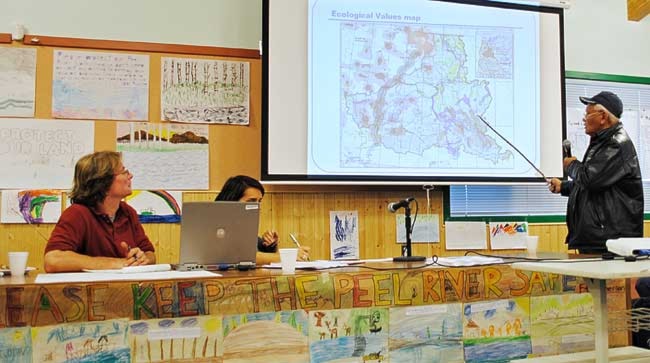FORT MCPHERSON
Tetlit Gwich’in elder Robert Alexie has travelled to places in the Peel that most people have only read or heard about.
Raised on the Trail River, he’s been up the Hart, Wind, Blackstone and Ogilvie Rivers - sometimes by dog team, sometimes on foot.
In more recent years, he’s returned to some of those places again, by raft and snowmobile, to share them with young people from his community of 800, perched on the banks of the lower Peel River.
“As I travel around I can see where my people have been - you know that’s given me a lot of power,” Alexie told more than 50 people packed into the Peel consultation meeting Tuesday.
But when he looks at the map in the recommended Peel land-use plan, he can’t understand why some places he thinks are important - like the Blackstone and Ogilvie rivers - have been left open for industrial development.
Alexie thinks they should also be protected along with the rest of the watershed.
“If we leave that alone, if it’s protected, our people will be wealthy for the rest of their lives,” Alexie said.
Everyone who spoke - from elders to newly elected Tetlit Gwich’in Chief William Koe to grade school children, whose “protect the Peel” posters lined the meeting room walls - delivered the same message.
“Our ancestors protected it (the Peel) for many years and they looked after it and now it’s our turn,” Koe told Yukon government officials and the standing-room-only crowd.
Whatever happens in the upper Peel affects everything and everybody downstream, he reminded them.
Just look at Northern Alberta, where deformed fish with large tumours or no fins, are being pulled from the waters downriver from the massive oilsands developments.
“We hear about the Athabasca River, oilsands, poison leaking into the rivers,” said elder Mary Teya. “Pollution is killing their fish, affecting their water, affecting their people - diseases of different types. “
The Peel needs 100 per cent protection to ensure its water and its people don’t suffer a similar fate, she said.
“I can’t sit back and say nothing. I can’t sit back and think it’s OK. I’m not letting it go by any more,” Teya said. “I’m in my old age now and I need to speak up on behalf of my people.”
Bertha Francis was born in the mountains of the upper Peel when the region was still part of her people’s annual trek between winter hunting grounds and summer fishing camps.
“I feel as though I belong there and that land belongs to me,” she said. “We want 100 per cent protection and we want you people to know that.”
Eighty-year-old Jane Charlie would love to see the entire watershed protected. The Bonnet Plume River is named after her grandfather, Andrew Bonnetplume, and she grew up on stories about her people travelling the region, sometimes in large mooseskin boats.
But she’s a little skeptical.
She’s seen many government consultation teams come and go and they’re all the same.
They sit and listen, and then “walk out and forget” all they’ve heard, she said, her young grandson at her side.
“I wonder if they’re going to listen to us,” Charlie said. “This time I hope something happens.”
Charlie Snowshoe is still trying to get a straight answer to why thousands of mineral claims were staked after the planning commission began its work.
He first asked about them two weeks ago at the Inuvik consultation meeting but didn’t have much luck. This time around he didn’t fare much better.
Yukon land-use planner Jen Meurer told him all five governments - Yukon, Na-cho Nyak Dun, Tr’ondek Hwech’in, Gwich’in Tribal Council and Vuntut Gwitchin - agreed to let staking continue while the plan was developed.
“If you look at the terms of reference on the planning commission, all five parties to the planning process agreed to those terms during the planning process,” she said.
But the terms of reference - which can be found in chapter one of the recommended Peel plan - make no mention of mineral staking or any such agreement.
In fact, the commission asked for a staking ban while it did its work, but the request was refused by the Yukon government.
Gwich’in Tribal Council president Richard Nerysoo used the McPherson meeting to update the community about his group’s political position on the Peel.
He assured those in attendance the council supports protecting 100 per cent of the region from industrial development.
But, he said, it still needs to figure out if that should include other types of development. It also needs to decide what type of designation - a park, a refuge or whatever - would work best for the area.
“The position of the leadership is we want 100 per cent protection - the issue is what is the protection we are talking about,” Nerysoo said.
The last community consultation meeting is scheduled for Mayo on September 29. The public can submit comments on the recommended land use plan until Oct. 1.
Yukon writer Mary Walden is doing a series of stories as the Peel land use plan is developed. The former CBC journalist and Yukon News editor also co-owns a wilderness tourism company that does canoe trips in the region. You can read more Peel stories at http://peelwatershed.blogspot.com.
